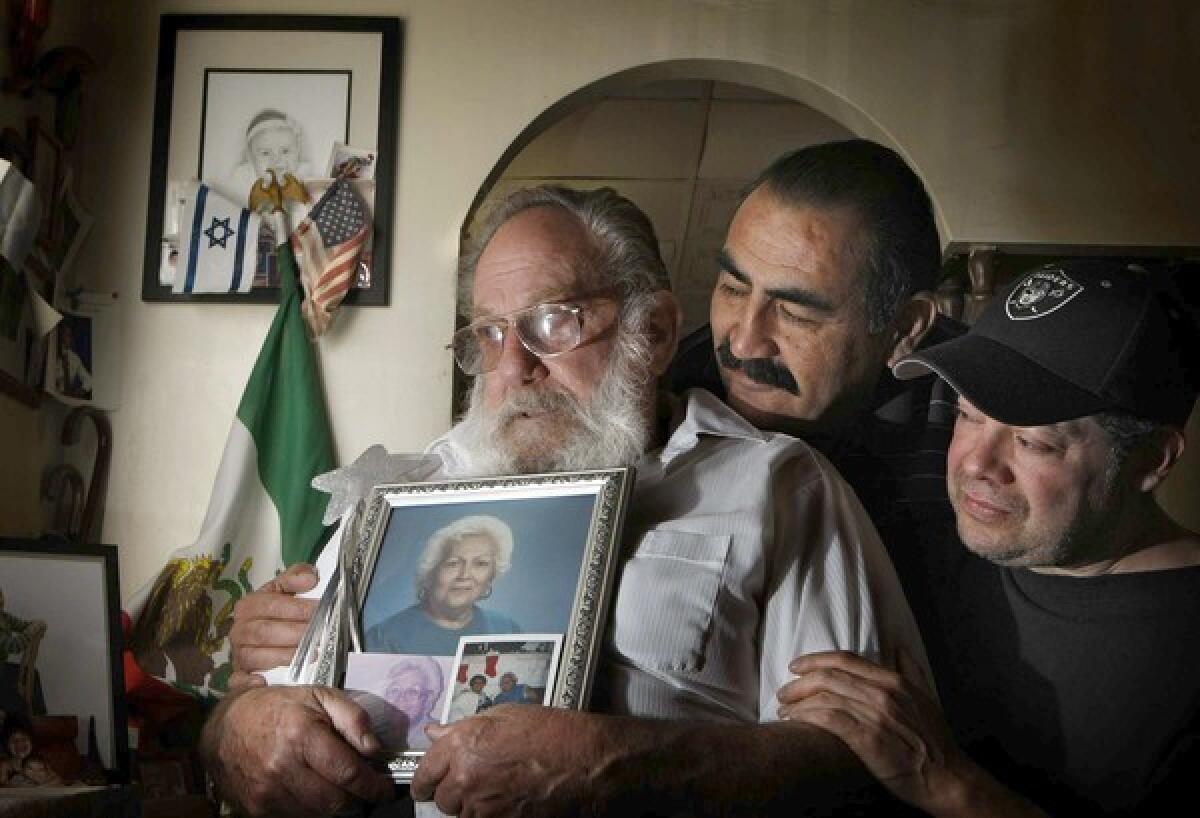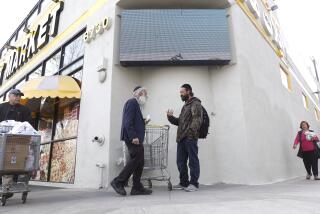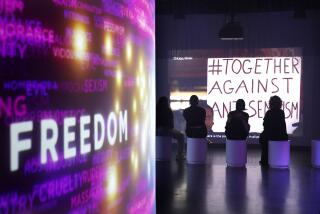One of a kind in Boyle Heights

The old man with the Santa Claus beard pulled a black yarmulke from the trunk of his Cadillac and limped across the street.
Hundreds of people had gathered outside an old synagogue in Boyle Heights for a program that looked back at the days when the neighborhood -- now overwhelmingly Latino and Catholic -- was the center of Jewish life in Los Angeles.
Leaning heavily on a cane, Eddie Goldstein, 76, wandered aimlessly, as if lost in thought. Finding a friend, he locked arms with her and walked into the long-shuttered Breed Street Shul. Eyes wide, Goldstein marveled at the faded grandeur of the building, which preservationists plan to turn into a community center.
Almost every other Jewish person there had come from miles away for the festival, which included music, food, a tour of the shul and a speech by the mayor. Goldstein had come from his home around the corner. Among his fellow Jews, he was a stranger.
As a boy, Goldstein worked at a kosher poultry shop where a rabbi wielded a razor-sharp blade to slit the throats of chickens before bleeding them upside-down. He remembers struggling to learn Hebrew and watching groups of ultra-Orthodox Jews, including rabbis and young rabbis in training, walk the streets of his native neighborhood in their black garb.
Then the Jewish families left. Jewish merchants on Brooklyn Avenue were slowly replaced by taquerias, quinceañera shops and botanicas. Eventually, the street itself was given a new name -- Cesar Chavez Avenue.
But Goldstein stayed. And in staying, he changed.
He married a Mexican American woman and became a father figure to her children. Every Sunday, he went to Mass with his Esther. She, in turn, kept him connected to the Jewish side of his life.
Faith had never been that important to Goldstein. It was Esther who pushed him to light yahrzeit candles in memory of loved ones, who reminded him when the High Holidays were approaching.
“She kept me more in my faith than I did,” said Goldstein, one of the last Jews in Boyle Heights. “She reminded me that I’m Jewish.”
Every year at Passover the family gathered at the home on Folsom Street. They would go to farmers markets to find the right ingredients -- chicken fat, fresh horseradish and jars of gefilte fish. Goldstein would make matzo and eggs and mix sour cream with grated beet juice. His children added salsa.
If Los Angeles ever had a melting pot, it was Boyle Heights in the first half of the 20th century. The neighborhood just east of downtown was home to Italians, Armenians, Russians, Japanese and Mexican Americans. It also had the largest concentration of Jews in the United States outside New York.
Like the cast of an “Our Gang” short, Goldstein’s friends in the 1930s and 1940s spanned the ethnicities.
“We were a League of Nations!” recalls his longtime friend, Art Manassian, now 78, and one of the neighborhood’s few remaining Armenian Americans.
As a boy, Goldstein worked at the National Theater on Brooklyn Avenue, which was called the “polly seed house” because of the abundance of sunflower seeds discarded on the floor. As a teenager, Goldstein worked in the rubbish business for Manassian’s father, driving all over the city to collect paper, metal and cardboard for recycling. He went to Roosevelt High School but never graduated and later became a meatpacker.
His mother and father, who divorced when he was 6, were not devout, but his grandmother was. On Jewish holidays, Goldstein would stand outside the Breed Street Shul and watch girls go in for services, but he rarely stepped inside. He tried to study the Torah for his bar mitzvah with other boys but didn’t get very far, he said.
“My other friends were reading in that Jewish style, swaying back and forth,” he said. “I couldn’t even get that rhythm. I said, ‘You know, I can’t do this.’ ”
After World War II, the gradual decline of the Jewish community in Boyle Heights accelerated. Many of Goldstein’s friends could afford homes in North Hollywood, Pico-Robertson, the Fairfax district and other new centers of Jewish life in Los Angeles.
“The Jewish guys that I knew, a lot of them became wealthy. Guys I grew up with, some of them became millionaires on the Westside of town, or wherever millionaires live,” he said. “I was a meatpacker.”
By the early 1960s, Goldstein said, there weren’t many Jews left in Boyle Heights. His mother and aunts died, along with his Uncle Louie, who had owned the Ebony Room, a bar on Brooklyn Avenue. His brothers moved to other neighborhoods.
He fell in love with Esther Guzman, a devout Catholic whom he had known growing up. She was 10 years older than Goldstein, had three children from a previous marriage, and had adopted three more. A week after they were married in the early 1960s, the couple adopted a baby, Steven. The youngest, he carried the Goldstein name.
Guzman’s oldest son, Art Perez, 59, said the religious and ethnic differences were never an issue in the household. “Eddie turned more Mexican than Jewish,” Perez said with a laugh.
Goldstein agrees: “I felt like I had Mexican blood in me,” he said. “I lived with them all my life.”
Among the Latinos who now filled the neighborhood, Goldstein made compadres and comadres, titles reserved for especially close friends or the godparents of one’s children. He shared pork carnitas in their homes and cooked a fine menudo for them in his own. He learned how to pickle pork feet in large jars.
The stucco home that he shared with Guzman and the children was in many ways a typical Mexican American, Catholic household on L.A.’s Eastside, brimming with religious artifacts, redolent of Mexican cooking.
Yet Tina Olmos, 49, one of the children adopted by Guzman, said Goldstein acted differently from the other parishioners at Assumption Church.
“I asked him why he didn’t stand up or kneel when we did, and he said, ‘Cause I’m Jewish. We don’t do that,’ ” she recalled. “People say that me and my youngest daughter resemble Ed. I guess if you live with someone long enough, you start to take on their traits.”
Goldstein said he enjoyed church, though it was not a religious experience for him. He said it felt strange, as the only Jew in the pews, to hear the priest talk so much about the land of Israel and the Jews. On a couple of occasions, he was godfather for friends’ children when they received first Communions or confirmations. He explained that being Jewish, he couldn’t make the sign of the cross because he didn’t want to be a hypocrite.
“Hey, I told them I’m Jewish,” he told one priest. To one nephew, who asked him to be his godfather, he said, “You know I’m Jewish though, mijo?”
In 2004, Esther died of cancer. Goldstein preserves a shrine to her in the corner of his living room. There are candles and a statue of St. Anthony holding the baby Jesus. Rosary beads are draped around the shoulders of a Sacred Heart of Jesus statue. Behind the display hang framed pictures of departed loved ones.
“I keep saints for them all,” Goldstein said in a scratchy voice with a lilting East L.A. accent.
There are few visible signs in the home that a Jewish man lives there, beyond a menorah in the corner of one room. Mostly, he preserves the home as a tribute to those who became his family, even though they weren’t related by blood.
“That’s my prieta. My Barbara,” he said proudly, using the Spanish word for a dark-skinned girl as he pointed to a picture of a granddaughter in a hallway.
Since Esther’s death, Goldstein gets out less, and some of his neighbors worry about him. Carolina Olmos, 86, said he looked lonelier than ever.
“There’s a Mexican saying: ‘Llora pobre y no solo,’ ” Olmos said. Better to cry because you are poor than because you are alone.
Goldstein says he feels pretty low sometimes. When his wife was alive, the home was filled with children and grandchildren almost every weekend.
Channeling his inner Jewish mother, he recently unhooked his phone, thinking that maybe the children would show up “to see if I was lying on the floor or something.”
A few weeks later, his son, Art Perez, moved back in with Goldstein after being laid off from his job. One night, Perez heard a burst of noise from the street and ran into the living room, screaming, “Pops, Pops, they’re shooting!”
Sitting on the couch watching TV, Goldstein calmly turned around. “Oh, I’m sorry mijo,” he said. “I forgot to tell you they’ve been shooting firecrackers.” They laughed.
“I guess when you leave the barrio, you forget the sounds,” Goldstein said later.
One of his friends, Lucy Delgado, had urged him to go to the street festival in late May at the old synagogue. Goldstein didn’t want to go. The next day, they walked into the Breed Street Shul arm in arm for what had been billed as a “Fiesta Shalom,” a celebration of peace.
All around him were Jews who had left half a century ago or their children and grandchildren. After so many years, Goldstein felt he identified more with the “Fiesta” than the “Shalom.”
“It felt strange seeing so many Jewish people, to be honest,” he said. “I’m kind of like the last Indian here.”
Before she died, he and Esther had talked about where they would be buried. Esther told him that she wanted them laid to rest in the same place.
He had her buried in the Home of Peace Jewish cemetery in Boyle Heights, which is also his intended resting place.
He sees no contradiction or awkwardness in placing his wife, a Catholic with whom he went to Mass every Sunday, in a Jewish burial ground. He embraces the dissimilar pieces of his life without embarrassment. It’s the same outlook that allowed him to feel at home as a Jew in Boyle Heights, even after he became one of the very last ones.
“The important thing for me was to be buried in Boyle Heights,” he said. “These are my people.”
More to Read
Sign up for Essential California
The most important California stories and recommendations in your inbox every morning.
You may occasionally receive promotional content from the Los Angeles Times.










